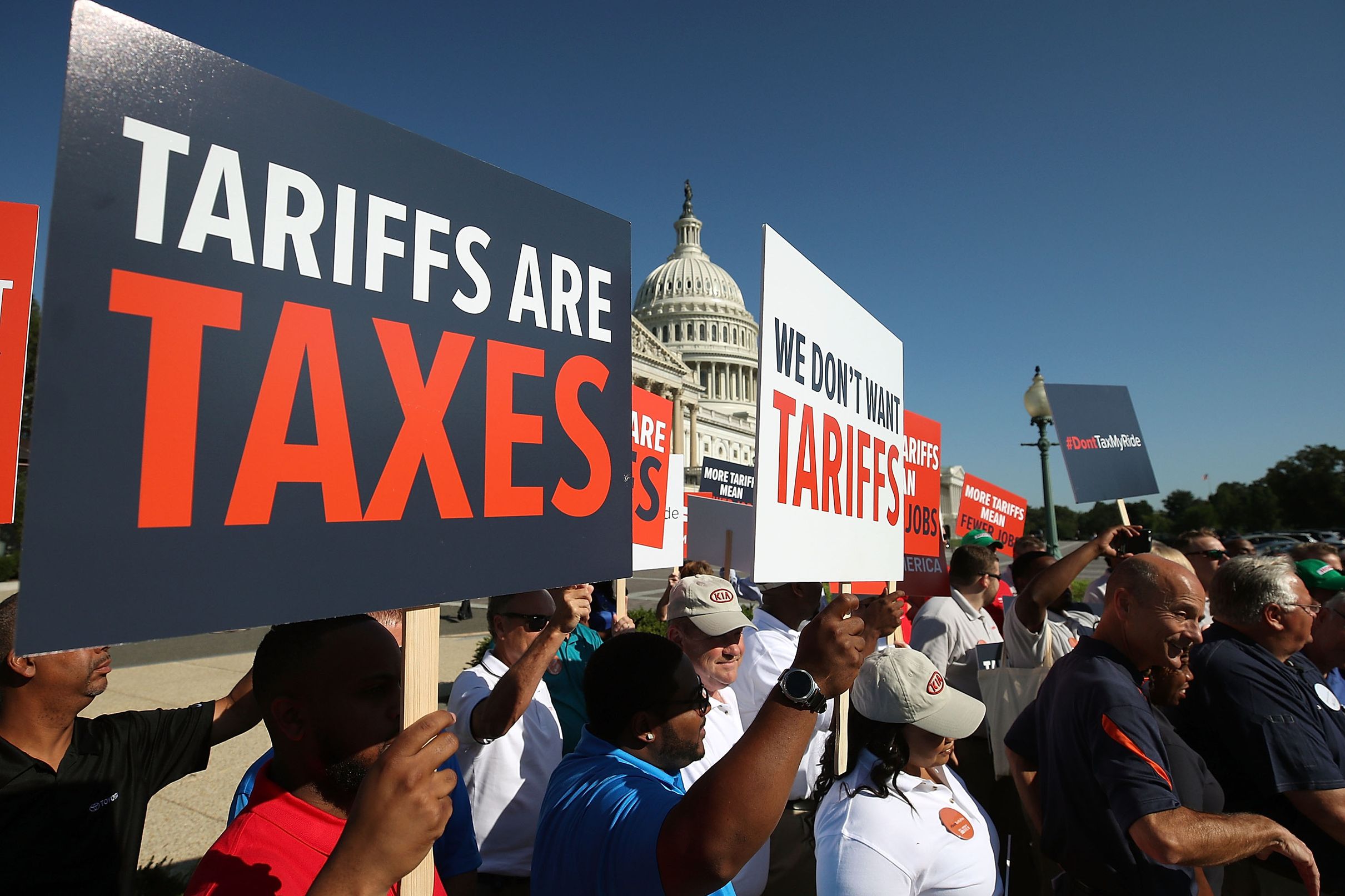Trump Tariff Impact: The Automotive Industry's Uncertain Future

Table of Contents
Increased Costs and Reduced Competitiveness
The Trump tariffs led to a substantial increase in costs and reduced competitiveness for many players in the automotive industry. This manifested in two primary ways: higher input costs for auto manufacturers and a loss of export markets for US automakers.
Higher Input Costs for Auto Manufacturers
The tariffs directly increased the price of imported parts, including crucial materials like steel and aluminum. This had a ripple effect:
- Increased prices for imported parts: Tariffs added a significant premium to the cost of importing essential components, squeezing profit margins.
- Reduced profit margins and pressure to raise vehicle prices: To maintain profitability, auto manufacturers were forced to either absorb the increased costs (reducing profit) or pass them onto consumers through higher vehicle prices.
- Shifting production to domestic suppliers: Many manufacturers attempted to mitigate the impact of tariffs by sourcing parts from domestic suppliers. However, this wasn't always feasible or economically advantageous, sometimes leading to even higher production costs domestically due to different factors like labor or raw material costs.
- Example: The increased cost of steel imports significantly impacted the production costs of large vehicles like trucks and SUVs, leading to price increases for consumers.
Loss of Export Markets for US Automakers
Retaliatory tariffs imposed by other countries on US-made vehicles severely hampered the export capabilities of American automakers.
- Retaliatory tariffs imposed by other countries: Countries affected by US tariffs responded with their own tariffs on American-made cars.
- Reduced demand for US cars in key export markets: The higher prices caused by retaliatory tariffs reduced the competitiveness of US vehicles in international markets.
- Loss of market share to foreign competitors: Foreign automakers gained a competitive edge in markets where US vehicles were previously strong.
- Example: Reduced US car exports to China and the European Union significantly impacted the profitability and market share of US auto manufacturers.
Disruption of Automotive Supply Chains
The Trump tariffs triggered a significant disruption of globally integrated automotive supply chains, adding complexity and cost.
Global Supply Chain Fragmentation
The tariffs forced manufacturers to rethink their sourcing strategies, leading to fragmented and less efficient supply chains.
- Tariffs disrupting established supply chains: Companies were forced to abandon long-standing relationships with suppliers due to tariff-related cost increases.
- Increased complexity and costs associated with managing multiple suppliers: Managing a more geographically diverse set of suppliers increased logistical challenges and costs.
- Delays in production due to disruptions in the supply of critical components: Disruptions in supply chains resulted in production delays and shortages of vehicles.
- Example: A shortage of a specific electronic component from a tariff-affected country could halt an entire assembly line, costing the manufacturer significant revenue and potentially leading to production delays.
Restructuring of Manufacturing and Sourcing Strategies
In response to the tariff-induced chaos, many companies underwent substantial restructuring efforts.
- Companies shifting production to countries with lower tariffs or more favorable trade agreements: Manufacturers relocated production to countries with less restrictive trade policies.
- Investments in new factories and supply chains in different geographic locations: Significant capital expenditures were made to establish new production facilities and sourcing networks in different regions.
- Increased reliance on regional sourcing and the development of more localized supply chains: The focus shifted towards regionalization and shorter supply chains to reduce reliance on distant suppliers.
- Example: Ford's decision to increase production in Mexico is a prime example of companies shifting manufacturing in response to the complexities and economic impacts of tariffs.
Impact on Consumers and the Overall Economy
The consequences of the Trump tariffs extended beyond the auto industry itself, affecting consumers and the broader economy.
Higher Vehicle Prices
Increased production costs, directly resulting from the tariffs, were largely passed on to consumers.
- Increased production costs passed onto consumers through higher vehicle prices: Higher prices for raw materials and imported components resulted in higher sticker prices for new vehicles.
- Reduced affordability and decreased consumer demand for new vehicles: Higher prices dampened consumer demand, leading to a reduction in overall automotive sales.
- Potential for reduced overall automotive sales: The decrease in affordability caused by higher prices negatively affected market sales and consumer confidence.
- Example: The price of pickup trucks, significantly impacted by higher steel costs, increased dramatically, making them less accessible to many consumers.
Job Losses and Economic Uncertainty
The disruptions in the automotive industry resulted in job losses and widespread economic uncertainty.
- Job losses in certain sectors of the auto industry due to reduced production or factory closures: Plant closures and reduced production led to significant job losses in regions heavily dependent on the automotive industry.
- Uncertainty in the economy leading to decreased investment and hiring in the automotive sector: The uncertainty surrounding the tariff situation discouraged investment and hiring in the sector.
- Ripple effects throughout related industries (e.g., dealerships, parts suppliers): The negative impacts spread to related industries, amplifying the overall economic downturn.
- Example: Plant closures in the American Midwest, where automotive manufacturing is prevalent, resulted in significant job losses and economic hardship for affected communities.
Conclusion
The Trump tariffs had a profound and complex impact on the automotive industry, leading to increased costs, supply chain disruptions, and significant economic uncertainty. The long-term effects are still unfolding, highlighting the vulnerability of globally integrated industries to protectionist trade policies. Understanding the lasting consequences of these tariffs is crucial for navigating the future of the industry. To stay informed on the ongoing implications and strategies for adapting to such economic shifts, continue researching the long-term effects of Trump tariffs on the automotive industry. Staying abreast of these developments is essential for all stakeholders in the global auto market, from manufacturers and suppliers to consumers and policymakers.

Featured Posts
-
 Wsayl Alielam Alerbyt Wwaqet Mhajmt Alqaflt Alinsanyt Almtjht Ila Ghzt
May 03, 2025
Wsayl Alielam Alerbyt Wwaqet Mhajmt Alqaflt Alinsanyt Almtjht Ila Ghzt
May 03, 2025 -
 A Place In The Sun Tips For Buying Property Abroad
May 03, 2025
A Place In The Sun Tips For Buying Property Abroad
May 03, 2025 -
 L Intimite D Emmanuel Et Brigitte Macron Confidences Apres Des Annees De Mariage
May 03, 2025
L Intimite D Emmanuel Et Brigitte Macron Confidences Apres Des Annees De Mariage
May 03, 2025 -
 Deep Divisions In Reform Uk Analysing The Current Crisis
May 03, 2025
Deep Divisions In Reform Uk Analysing The Current Crisis
May 03, 2025 -
 Nigel Farages Influence On The Uks Reform Party
May 03, 2025
Nigel Farages Influence On The Uks Reform Party
May 03, 2025
